Hong Kong scientists join search for alien life, hope to discover whether we are alone in the universe
* The University of Hong Kong’s Laboratory for Space Research specialises in planetary and space science, high-energy astrophysics and late-stage stellar evolution
* A satellite/telescope will soon be sent into space to observe galaxy clusters and dark matter
Given its role as a global business centre, it’s little wonder that most people marvelling at Hong Kong’s night sky are looking at the glittering skyscrapers rather than the Milky Way or Mars.
But that may be changing, thanks to a few forward-thinking researchers at the University of Hong Kong (HKU) working at the west end of Hong Kong Island. Since 2016, HKU has been renting space for its Laboratory for Space Research (LSR) at the Cyberport Business Park. And from here, Hong Kong is doing its bit in the search for, among other things, alien life.
Overlooking Telegraph Bay, the LSR, funded by a HK$10.8 million (US$1.4 million) government development grant, conducts research into fields such as astrochemistry, astrobiology, high-energy physics and planetary science.
“I’m trying to secure and grow the LSR so that we can be productive and impactful,” its director, Quentin Parker, explains to me on a recent visit to the lab. “We are striving to be Asia’s global university and we are not ignoring the tremendous potential in the greater world to connect, collaborate and build links,” says the astrophysicist, who points to recent collaborations with Peking University, Zhejiang University and Nanjing University.
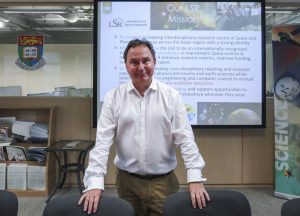
Professor Quentin Parker, director of the University of Hong Kong’s Laboratory for Space Research. Photo: Jonathan Wong
He says the LSR – whose strengths lie in planetary science, space science, high-energy astrophysics and late-stage stellar evolution – recently received another HK$10 million, from HKU’s senior management, to establish a sister lab at the mainland’s Zhejiang Institute of Research Innovation (ZIRI). And as early as this October, the LSR, in conjunction with Nanjing University, will see the launch of its first satellite/telescope.
The “NJU-HKU No.1” will be shot into space on a Chinese rocket from one of the four launch sites in China. The 50kg X-ray telescope will look at nearby galaxy clusters to try to discern, among other things, dark matter – theoretical material that has yet to be directly observed. The 50 million yuan (US$7.4 million) satellite’s wide-angle vision should also offer a unique view of comets in our solar system and the interaction of the solar wind with the Earth’s magnetosphere.
Might it find evidence of alien life forms? Well, possibly: the endgame for a star often triggers the kind of astrochemical reactions that may enable life to develop.
A 2017 paper in the Nature Astronomy journal highlighted observations of a dying star some 17,000 light years away. Co-author Xuan Fang, an LSR postdoctoral fellow at HKU’s Department of Physics, discovered that even dying stars can revitalise their surroundings, by ejecting material from their surfaces unusually late in their evolution.
Using the Spanish Nordic Optical Telescope, Fang had observed the planetary nebula HuBi 1’s inner and outer structure. A planetary nebula is an expanding shell of hot gas that surrounds an ageing star. Fang and his colleagues caught the nebula’s central star in a moment of high ultraviolet flux. The team observed HuBi 1 at the exact moment its central star underwent a brief “born-again” process to become a hydrogen-poor and metal-rich body, Fang said in a statement.
As well as the life and death of stars, LSR research covers the astrochemistry involved in the organic building blocks of planets – and thus, potentially, life – a subject close to the heart of HKU Professor Emeritus Sun Kwok.
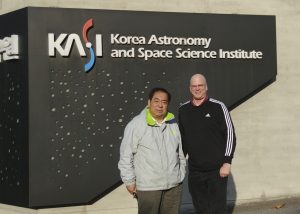
University of Hong Kong Professor Emeritus Sun Kwok and journalist Bruce Dorminey. Photo: Bruce Dorminey
A week or so after my visit to Cyberport, Kwok greets me at the gates of the Korea Astronomy and Space Science Institute, an hour or so south of Seoul. We walk up a steep hill covered by trees in the midst of an autumnal colour change.
Kwok served as dean at HKU’s Faculty of Sciences from 2006 to 2016, and until last year as president of the International Astronomical Union’s Astrobiology Commission. He now lives in Vancouver, Canada, and is in Korea to attend an international conference on cosmic magnetism and organic dust: life’s building blocks, of which this beautiful landscape is so indicative.
Kwok leads me to a second-floor conference room and begins recounting his multi-year quest to turn HKU into a centre for astronomical science.
Understanding how life formed here on Earth, may have formed on Mars, and may propagate itself throughout the cosmos are some of humanity’s most challenging scientific and philosophical puzzles. And astronomical science always seems to find its way back to the basic questions: where did we come from? Where are we going? And are we alone in the universe?
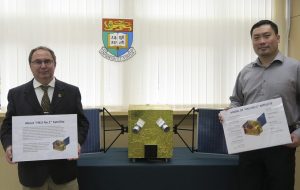
Parker (left) and Dr Su Meng attend a presentation for the “NJU-HKU No.1” satellite/telescope. Photo: HKU LSR
Kwok and his colleagues are making progress in at least defining the parameters of such profound conundrums. One of the most pressing questions goes as follows: do the complex organics needed for life (those with a large number of carbon atoms) in any solar system originate in isolation within the forming nebula or do they need chemical reactions and processing from earlier generations of stars?
“My [contention] is that when ordinary stars die, they produce large amounts of organics,” says Kwok. “These organics travel across the Milky Way and are embedded in forming solar systems.”
The availability of this material makes life more likely, says Kwok. His argument is that since these complex organics can be made by many billions of stars and are then ejected all over the Milky Way, the conditions needed for the creation of life should be as common on many other planets as they were on Earth.
But will we ever be able to determine whether life on Earth was dependent on organics formed by dying stars? Or were life’s building blocks formed within our solar system?
“We will get there eventually,” says Kwok. “By using isotopic ratios, there are ways to tell if the organics in the solar system have come from stars or not.”
“Based on what we think we know about surface life formation and evolution on Earth, it is hard to imagine that the surface of Mars would have ever been a good place for life”
Joseph Michalski, geologist and planetary scientist
Seyedabdolreza Sadjadi, an HKU postdoctoral fellow in computational quantum astrochemistry, is struggling with a similar mystery, a discovery made by Nasa’s Cassini spacecraft during fly-by observations of Saturn’s frozen moon Enceladus between 2004 and 2008. Cassini confirmed that ice grains containing concentrated and complex macromolecular organic material lay beneath Enceladus’ icy surface.
Sadjadi wonders how those molecules got there? Did they form on the moon or were they transported to Enceladus? And if they came from elsewhere, Sadjadi wonders, how did the molecules withstand the chaos and radiation of space. “It’s a miracle to me how they [would have survived] the space environment,” says Sadjadi.
Closer to home, recent LSR research has cast doubt on whether Mars could ever have sustained surface life.
“Based on what we think we know about surface life formation and evolution on Earth, it is hard to imagine that the surface of Mars would have ever been a good place for life,” says Joseph Michalski, a geologist and planetary scientist at HKU’s Department of Earth Sciences. The main reason, he notes, is that Mars’ protective magnetic field is thought to have shut down about 4.1 billion years ago, leaving the Red Planet at the mercy of solar wind, galactic cosmic rays and the sun’s own ultraviolet output. LSR research suggests the planet’s climate has probably been inhospitably cold and dry for most of its history. Any liquid water at the surface would have been short lived.
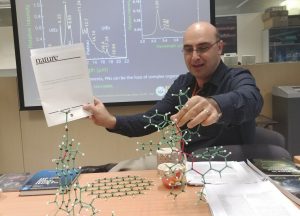
Seyedabdolreza Sadjadi. Photo: HKU LSR
However, Michalski says, Mars’ subsurface is interesting as a potential microbial habitat because it would have been protected from radiation and have been more stable, with longer-lived fluids and sustained chemical interactions. If there is subsurface life on Mars, the McLaughlin Crater is where it might be found.
“This is an area where subsurface fluids and their contents would have emerged into a lake environment,” says Michalski. In a paper that has been accepted for publication in the Journal of Geophysical Research, Michalski, the lead author, notes that a 4 billion-year-old sedimentary lake basin in the McLaughlin Crater may have sequestered and preserved organic materials for future exploration by a rover. The lake probably contained a variety of sedimentary environments and is the only place on Mars where fine‐grained, underwater “landslides”, called turbidites, have been identified. These regions are important because, on Earth, such deposits can preserve organic matter.
Despite these revelations about a planet in our own solar system, most astronomical targets lie much further afield, well beyond our stellar neighbourhood. If HKU is going to be a serious partner in global astronomical endeavours, the university needs to have better access to ground-based optical telescopes.
A good first step was last month’s signing of an agreement with the National Astronomical Observatory of China (NAOC) to allow all Hong Kong astronomer groups access to all of the mainland’s ground-based facilities and those already available to the NAOC through international agreements. Hong Kong astronomers can now apply for time on some of the best telescopes in open competition with their mainland peers. Parker says it’s also possible to buy time on some of the world’s top telescopes.
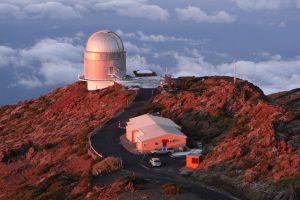
The Nordic Optical Telescope, in La Palma, Canary Islands, Spain. Photo: Alamy
Two decades ago, few at HKU seemed to care about astronomy, much less the esoteric sciences. If they were interested in technology at all, researchers were likely to be looking at robotics or artificial intelligence. However, as Kwok points out, astronomy and its subdisciplines of astrobiology, astrochemistry and planetary science are inherently interdisciplinary.
Kwok says he’s most proud of two achievements during his time as dean of the Faculty of Sciences.
“I totally changed the science curriculum and was able to recruit on a large scale internationally,” he says.
“The world is only beginning to recognise China’s strong efforts in science,” says Kwok. “China has committed significant resources to build new facilities in the coming decades.” Although Hong Kong is limited in its ability to contribute hardware, he says, the city’s contributions can be in software and data analysis.
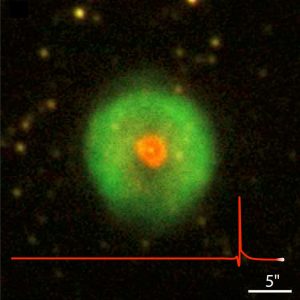
Planetary nebula HuBi 1. Photo: HKU LSR
But how does he counter the local view that astronomy is too esoteric a field to support the needs of a growing population worried primarily about finding high-paying jobs?
Kwok contends that Hong Kong is wealthy enough to afford the luxury of intellectual pursuits. The idea, he says, is to try to generate a population that is less materialistic and more interested in the sciences, arts and culture.
“There are over 10,000 amateur astronomers in Hong Kong,” says Kwok. “People are curious.”
And you never know; the person to eventually discover life beyond Planet Earth might just be a Hongkonger.
Bruce Dorminey is a science journalist and author of Distant Wanderers: The Search for Planets Beyond the Solar System (2002).

